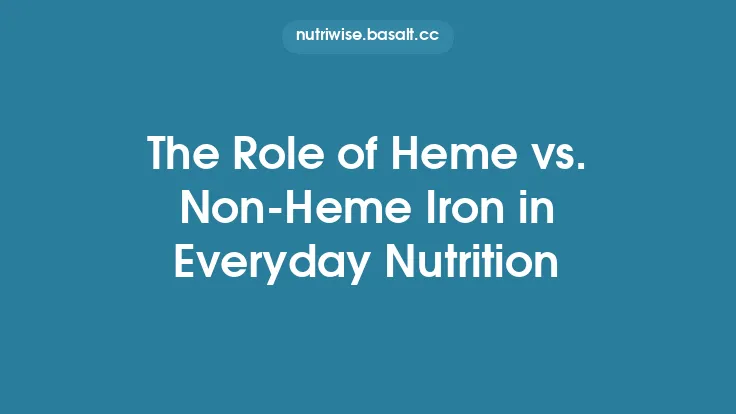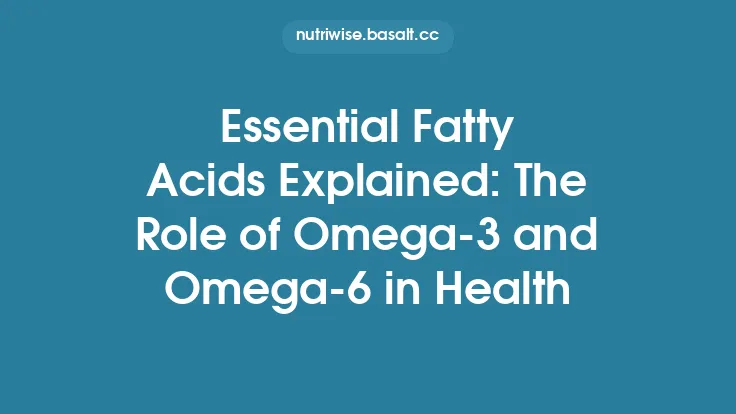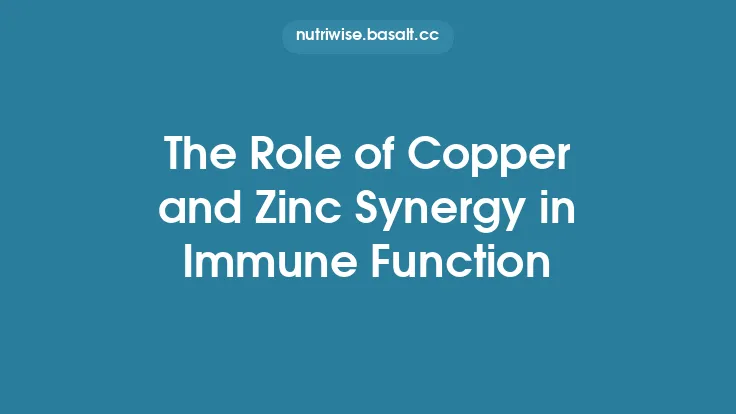Vitamin C (ascorbic acid) is one of the most widely studied micronutrients, yet its specific contribution to the body’s defense against oxidative stress remains a nuanced topic that bridges biochemistry, cell biology, and clinical research. While the vitamin is celebrated for its broad antioxidant capacity, a focused look at how it mitigates oxidative damage reveals a series of interrelated actions that operate at the molecular, organelle, and systemic levels. This article delves into those actions, emphasizing the mechanisms by which vitamin C counters reactive oxygen species (ROS), preserves cellular integrity, and influences redox‑sensitive signaling pathways—all without venturing into the broader themes of immune modulation, collagen synthesis, cardiovascular protection, or general supplementation guidelines.
Understanding Oxidative Stress at the Cellular Level
Oxidative stress arises when the production of ROS outpaces the capacity of endogenous antioxidant defenses. ROS—including superoxide anion (O₂⁻·), hydrogen peroxide (H₂O₂), hydroxyl radical (·OH), and singlet oxygen (¹O₂)—are generated as by‑products of aerobic metabolism, particularly within the mitochondrial electron transport chain, peroxisomes, and NADPH oxidases. In physiological amounts, ROS serve as signaling molecules that regulate processes such as cell proliferation, apoptosis, and immune responses. However, excessive ROS can oxidize lipids, proteins, and nucleic acids, leading to membrane disruption, enzyme inactivation, and mutagenesis.
The cellular redox environment is tightly regulated by a network of enzymatic antioxidants (e.g., superoxide dismutase, catalase, glutathione peroxidase) and non‑enzymatic molecules (e.g., glutathione, uric acid, vitamin C). The balance is dynamic: a transient rise in ROS can trigger adaptive responses (hormesis), whereas chronic elevation contributes to pathophysiological states such as neurodegeneration, metabolic syndrome, and age‑related functional decline. Understanding where vitamin C fits into this network requires an appreciation of its physicochemical properties and its distribution across cellular compartments.
Vitamin C as a Primary Water‑Soluble Antioxidant
Vitamin C is a small, water‑soluble molecule that readily diffuses across cytosolic and extracellular spaces. Its redox potential (E°′ ≈ +0.28 V for the ascorbate/dehydroascorbate couple) positions it as an effective electron donor capable of neutralizing a variety of ROS. Unlike many enzymatic antioxidants that require cofactors or specific substrates, ascorbate can directly interact with oxidants in the aqueous milieu, making it a first line of defense against ROS that arise in the cytosol, plasma, and interstitial fluids.
The vitamin’s amphipathic nature also allows limited partitioning into the inner leaflet of the plasma membrane, where it can intercept radicals that have diffused out of the lipid bilayer. This dual presence—predominantly aqueous but with membrane‑associated activity—enables vitamin C to protect both hydrophilic and, to a lesser extent, lipophilic cellular components.
Direct Scavenging of Reactive Oxygen Species by Vitamin C
The most straightforward antioxidant action of vitamin C is the direct donation of electrons to ROS, converting them into less reactive species. Key reactions include:
| ROS | Reaction with Ascorbate | Resulting Products |
|---|---|---|
| Superoxide (O₂⁻·) | O₂⁻· + AscH⁻ → H₂O₂ + Asc· | Hydrogen peroxide + ascorbyl radical |
| Hydrogen peroxide (H₂O₂) | H₂O₂ + AscH⁻ → H₂O + dehydroascorbate (DHA) | Water + DHA |
| Hydroxyl radical (·OH) | ·OH + AscH⁻ → H₂O + Asc· | Water + ascorbyl radical |
| Peroxyl radical (ROO·) | ROO· + AscH⁻ → ROOH + Asc· | Alkyl hydroperoxide + ascorbyl radical |
In each case, the ascorbyl radical (Asc·) formed is relatively stable and can be recycled back to ascorbate by cellular reductants (e.g., glutathione, NADH). The net effect is the conversion of highly reactive radicals into benign molecules (water, alcohols) while preserving the redox balance.
Importantly, vitamin C does not directly detoxify the hydroxyl radical generated via the Fenton reaction (Fe²⁺ + H₂O₂ → Fe³⁺ + ·OH + OH⁻). However, by reducing Fe³⁺ back to Fe²⁺, ascorbate can paradoxically sustain the Fenton cycle. In physiological contexts, this pro‑oxidant potential is mitigated by the tight regulation of free iron through ferritin and transferrin, and by the concurrent presence of other antioxidants that sequester transition metals.
Regeneration of Other Antioxidant Systems by Vitamin C
While the primary focus here is oxidative stress, it is worth noting that vitamin C participates in a redox “recycling” network. The ascorbyl radical can be reduced back to ascorbate by reduced glutathione (GSH) via the reaction:
Asc· + 2 GSH → AscH⁻ + GSSG
This interaction links the vitamin’s antioxidant capacity to the glutathione system, ensuring that the pool of reduced glutathione—critical for detoxifying peroxides via glutathione peroxidase—remains replenished. Although the broader topic of inter‑antioxidant interactions is covered elsewhere, this brief mechanistic link underscores how vitamin C contributes to the overall resilience of the cellular redox environment.
Vitamin C in Mitochondrial Protection and Energy Metabolism
Mitochondria are both the primary source and a major target of ROS. The electron transport chain (ETC) leaks electrons at complexes I and III, forming superoxide that is rapidly dismutated to H₂O₂. Excessive mitochondrial ROS can impair oxidative phosphorylation, trigger the opening of the permeability transition pore, and initiate apoptosis.
Vitamin C accumulates within the mitochondrial matrix at concentrations severalfold higher than in the cytosol, a phenomenon facilitated by specific transporters (e.g., the sodium‑dependent vitamin C transporter SVCT2). Within mitochondria, ascorbate exerts several protective actions:
- Scavenging of H₂O₂ – By reducing H₂O₂ to water, vitamin C limits the substrate available for the Fenton reaction, thereby curbing hydroxyl radical formation near mitochondrial DNA (mtDNA) and membrane lipids.
- Preservation of Cardiolipin – Cardiolipin, a phospholipid unique to the inner mitochondrial membrane, is highly susceptible to peroxidation. Vitamin C can intercept peroxyl radicals that attack cardiolipin, preserving the integrity of ETC supercomplexes.
- Support of Mitochondrial Antioxidant Enzymes – Ascorbate helps maintain the reduced state of mitochondrial peroxiredoxins and thioredoxin 2, both of which are essential for detoxifying peroxides generated during respiration.
- Modulation of Mitochondrial Biogenesis – Emerging evidence suggests that vitamin C influences the activity of transcription factors such as PGC‑1α (peroxisome proliferator‑activated receptor gamma coactivator 1‑alpha) through redox‑dependent signaling, thereby affecting mitochondrial turnover and capacity.
Collectively, these actions position vitamin C as a sentinel within the organelle most vulnerable to oxidative insult.
Modulation of Redox‑Sensitive Signaling Pathways
Beyond direct radical scavenging, vitamin C can shape cellular responses by influencing redox‑sensitive signaling cascades. Two pathways of particular relevance to oxidative stress are:
1. Nuclear Factor Erythroid 2‑Related Factor 2 (Nrf2)
Nrf2 is a transcription factor that, when activated, translocates to the nucleus and binds antioxidant response elements (ARE) in the promoters of genes encoding detoxifying enzymes (e.g., NAD(P)H:quinone oxidoreductase 1, heme oxygenase‑1). Vitamin C can indirectly promote Nrf2 activation by maintaining a reduced intracellular environment that favors the dissociation of Nrf2 from its inhibitor Keap1. In experimental models, ascorbate supplementation has been shown to enhance the expression of Nrf2‑target genes, thereby bolstering the cell’s endogenous antioxidant capacity.
2. Mitogen‑Activated Protein Kinases (MAPKs)
The MAPK family (ERK, JNK, p38) responds to oxidative cues, mediating outcomes ranging from proliferation to apoptosis. Vitamin C can attenuate the over‑activation of stress‑activated MAPKs (JNK and p38) by limiting ROS‑driven upstream kinases. This modulation helps prevent the propagation of oxidative damage signals that would otherwise lead to cell death or senescence.
Through these mechanisms, vitamin C exerts a regulatory influence that extends beyond mere chemical neutralization of ROS, integrating antioxidant defense with adaptive cellular programming.
Vitamin C’s Role in Protecting Biomolecules: Lipids, Proteins, and DNA
Oxidative damage manifests in three major biomolecular domains:
- Lipid Peroxidation – Polyunsaturated fatty acids (PUFAs) in cellular membranes are prime targets for peroxyl radical attack, generating lipid hydroperoxides and secondary aldehydes (e.g., malondialdehyde, 4‑hydroxynonenal). Vitamin C, by scavenging peroxyl radicals, interrupts the chain reaction of lipid peroxidation, preserving membrane fluidity and preventing the formation of electrophilic aldehydes that can modify proteins and DNA.
- Protein Oxidation – ROS can oxidize side chains of cysteine, methionine, and tryptophan residues, leading to altered enzyme activity, loss of structural integrity, and formation of carbonyl groups. Ascorbate can directly reduce oxidized cysteine residues (forming sulfenic acids) back to their thiol state, thereby restoring protein function. Moreover, by limiting the generation of carbonyl derivatives, vitamin C helps maintain proteostasis.
- DNA Damage – Oxidative lesions such as 8‑oxoguanine (8‑oxoG) arise when ROS attack nucleobases. These lesions can cause G→T transversions if unrepaired. Vitamin C contributes to DNA protection in two ways: (a) direct scavenging of ROS in the nucleus, and (b) supporting the activity of DNA repair enzymes (e.g., OGG1) through maintenance of a reduced intracellular milieu. In vitro studies demonstrate that ascorbate supplementation reduces the frequency of oxidative DNA lesions in cultured cells exposed to pro‑oxidant stressors.
By safeguarding these molecular classes, vitamin C helps preserve cellular homeostasis and prevents the cascade of dysfunction that follows unchecked oxidative damage.
Clinical Evidence Linking Vitamin C Status to Oxidative Stress Markers
A substantial body of human research has examined the relationship between circulating vitamin C concentrations and biomarkers of oxidative stress. While the literature is heterogeneous—owing to differences in study populations, assay methods, and intervention designs—several consistent patterns emerge:
- Cross‑Sectional Observations – Population studies frequently report inverse correlations between plasma ascorbate levels and markers such as F₂‑isoprostanes (lipid peroxidation) and protein carbonyls. For example, a large European cohort (n ≈ 5,000) found that individuals in the highest quartile of plasma vitamin C had ~30 % lower urinary F₂‑isoprostane excretion compared with those in the lowest quartile, after adjusting for age, smoking, and diet.
- Intervention Trials – Randomized controlled trials (RCTs) administering oral vitamin C (500 mg–2 g/day) for periods ranging from 4 weeks to 6 months have demonstrated reductions in oxidative biomarkers in specific contexts, such as exposure to environmental pollutants, high‑intensity exercise, and metabolic stress. Notably, a double‑blind RCT in endurance athletes showed a 22 % decrease in plasma malondialdehyde after 8 weeks of 1 g/day vitamin C supplementation, accompanied by improved recovery of antioxidant enzyme activities.
- Disease‑Specific Cohorts – In patients with early‑stage neurodegenerative disorders (e.g., mild cognitive impairment), higher baseline vitamin C status has been associated with slower progression of oxidative DNA damage, as measured by 8‑oxoG levels in peripheral blood mononuclear cells. While causality cannot be definitively established, these observations support a protective link.
It is essential to interpret these findings within the broader context of overall diet, lifestyle, and genetic factors influencing antioxidant capacity. Nonetheless, the converging evidence underscores that adequate vitamin C status is a measurable correlate of reduced oxidative stress in vivo.
Practical Considerations for Optimizing Vitamin C’s Antioxidant Capacity
Maximizing the antioxidant benefits of vitamin C does not require a prescriptive supplementation regimen; rather, it involves attention to factors that influence its bioavailability and functional longevity:
- Absorption Kinetics – Oral ascorbate is absorbed via sodium‑dependent transporters (SVCT1 in the intestine). Absorption efficiency declines at doses >200 mg, with excess vitamin C being excreted renally. For individuals seeking to sustain high plasma ascorbate during periods of oxidative challenge (e.g., intense training, acute pollutant exposure), dividing the total daily intake into multiple smaller doses can maintain steadier concentrations.
- Stability in the Gastrointestinal Tract – Ascorbate is sensitive to oxidation by gastric acid and metal ions. Consuming vitamin C with a modest amount of food, particularly those containing natural chelators (e.g., polyphenols), can protect it from premature oxidation and improve absorption.
- Tissue Distribution – Certain tissues (adrenal cortex, brain, immune cells) concentrate vitamin C via SVCT2. Ensuring adequate plasma levels supports the active transport mechanisms that deliver ascorbate to these high‑demand sites.
- Interaction with Lifestyle Factors – Smoking, chronic alcohol consumption, and high‑intensity physical activity increase oxidative load and can deplete vitamin C stores. Individuals exposed to these stressors may benefit from monitoring plasma ascorbate and adjusting intake accordingly, always within the bounds of safe upper limits (generally ≤2 g/day for adults).
- Avoiding Pro‑Oxidant Pitfalls – In the presence of free transition metals, high concentrations of ascorbate can catalyze the Fenton reaction. Maintaining adequate levels of metal‑binding proteins (e.g., ferritin, ceruloplasmin) through a balanced diet helps mitigate this risk.
By aligning intake patterns with physiological absorption dynamics and lifestyle demands, one can harness vitamin C’s antioxidant potential more effectively.
Future Directions in Research on Vitamin C and Oxidative Stress
The field continues to evolve, with several promising avenues poised to deepen our understanding of vitamin C’s role in oxidative homeostasis:
- Mitochondrial‑Targeted Ascorbate Analogs – Chemical conjugation of ascorbate to lipophilic cations (e.g., triphenylphosphonium) creates molecules that preferentially accumulate in mitochondria. Early preclinical studies suggest enhanced protection against mitochondrial ROS without systemic pro‑oxidant effects.
- Genetic Modulators of Ascorbate Transport – Polymorphisms in SVCT1 and SVCT2 genes influence individual variability in plasma and tissue vitamin C levels. Large‑scale genome‑wide association studies (GWAS) are beginning to map these variants, opening the door to personalized nutrition strategies.
- Systems Biology Approaches – Integrating metabolomics, transcriptomics, and redox proteomics can elucidate how vitamin C orchestrates network‑level responses to oxidative stress, particularly in aging tissues where redox balance shifts.
- Clinical Trials in Oxidative‑Stress‑Driven Pathologies – Ongoing RCTs are testing high‑dose vitamin C as an adjunct therapy in conditions characterized by chronic oxidative burden, such as early‑stage Alzheimer’s disease and chronic obstructive pulmonary disease. Outcomes will clarify whether sustained ascorbate elevation translates into clinically meaningful reductions in disease progression.
- Interaction with the Microbiome – Emerging data indicate that gut microbial composition can affect ascorbate metabolism, while vitamin C itself may modulate microbial redox environments. This bidirectional relationship could have implications for systemic oxidative status.
Continued interdisciplinary research will refine the therapeutic window in which vitamin C can be leveraged as a targeted antioxidant, moving beyond generic supplementation toward precision interventions.
In sum, vitamin C occupies a central niche in the body’s defense against oxidative stress. Its capacity to directly neutralize reactive oxygen species, protect critical biomolecules, support mitochondrial integrity, and modulate redox‑sensitive signaling pathways makes it an indispensable component of cellular resilience. While the vitamin’s broader health benefits span many domains, its specific actions against oxidative damage stand out as a cornerstone of micronutrient‑based antioxidant strategy. By appreciating the nuanced mechanisms outlined above, readers can better grasp how maintaining optimal vitamin C status contributes to the preservation of cellular health in the face of inevitable oxidative challenges.





